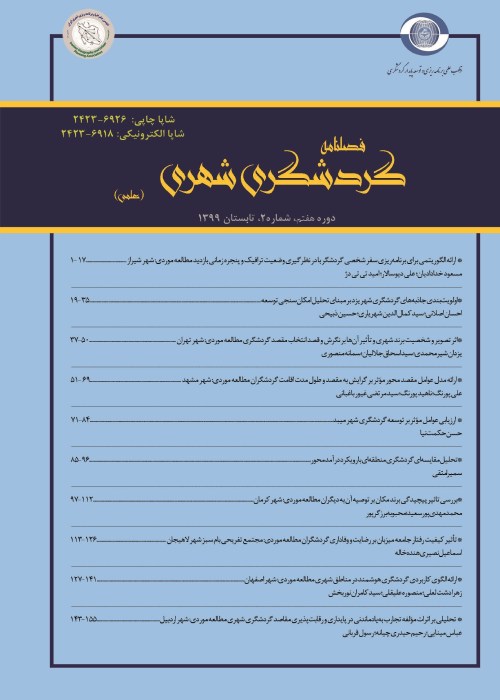The Role of Cultural Values in Tourist Wayfinding AnxietyCase Study: District 8 of Mashhad Municipality
Wayfinding is an important aspect that should be considered to help guide tourists to tourism cities. Citizens 'wayfinding behavior is different from tourists' wayfinding behavior due to differences in the degree of familiarity with the environment and different perceptions of the environment. This causes wayfinding anxiety among tourists. A basic principle in reducing tourists wayfinding anxiety in tourism cities is user-centered design and taking into account the cultural characteristics of tourists. Because urban tourism arises from the movement of human beings with different cultures, and each tourist, according to its cultural characteristics, emphasizes certain aspects of wayfinding. Considering the special cultural values of tourists and the impact on wayfinding behavior, there seems to be a significant relationship between cultural values of tourists and their wayfinding anxiety. Therefore, the main purpose of this study is to explain the effect of cultural values on the wayfinding anxiety of Azeri and Mazani subcultural tourists in District 8 of Mashhad Municipality for facilitate the wayfinding of these tourists. This study also explains the differences and similarities between the wayfinding anxiety of the tourists of the subcultures by emphasizing their cultural values.
This research is applied in terms of purpose and survey in terms of data collection method. District 8 of MashhadMunicipality has been selected as the environment of research due to the high potentials of tourism and the high volume of tourists and the lack of proper measures to facilitate their wayfinding. According to field observations and questions from the authorities of tourist accommodation, two subcultures Azeri (Provinces of East, West Azerbaijan, Ardabil) and Mazani (Mazandaran province), which constitute a large volume of the population of domestic tourists to District 8 of Mashhad Municipality, have been selected as a case study. The statistical population is domestic tourists in Mashhad in 2020 (30 million people) that the two groups of tourists (97 people) were purposefully sampled in District 8. Based on the prototype and estimating the ratio of Azeri tourists to Mazani (2: 1), the sample size is obtained according to the Cochran's formula. In this research, a combined comparative method has been used. First, after forming the research topic and determining the research questions and purpose, the theoretical framework was developed with the help of theoretical propositions. Then, field information was collected from the samples using a questionnaire. The validity of the questionnaire was obtained using Cronbach's alpha method in SPSS software, "0.711", which indicates the optimal validity of the questionnaire. The reliability of the questionnaire has been evaluated by face validity method by experts and its reliability has been confirmed.
According to the results of comparing the components of cultural values of tourists (Azeri and Mazani) in Mashhad using t-test, cultural values of "individualism/collectivism, masculinity/ femininity, uncertainty avoidance, orientation, negligence/strictness» with a significance rate of less than 0.05, have been associated with the subculture of tourists and have created a significant difference between Azeri and Mazani tourists. Also, by comparing the components of wayfinding anxiety of Azeri and Mazani tourists using t-test, the components of "getting lost, unfamiliarity with the environment, complexity of the environment, limited time for wayfinding, unsafe environments, spatial memory, adventure rate, survey strategy" with a significance level of less than 0.05, they have created a significant difference between Azeri and Mazani tourists, which can be explained according to the cultural values of each of the two groups of tourists under study. According to the findings from Chi-square and Kramer correlation tests, the amount of chi-square obtained by comparing the frequencies of Azeri and Mazani tourists in 5 variable classes of anxious situations in wayfinding is 21.094, which is statistically significant. The value of Kramer correlation coefficient is 0.466 and the criterion of decision is 0.000. Therefore, there is a significant relationship with high intensity between anxious situations and each two groups of tourists. Also the amount of chi-square obtained by comparing the frequencies of Azeri and Mazani tourists in 5 variable categories of wayfinding guidance tools is equal to 18.429 and the value of Kramer correlation coefficient is equal to 0.436 and the value of the decision criterion is 0.001. Therefore, there is a significant relationship with high intensity between wayfinding tools in times of anxiety and each of the two groups of tourists in this study. According to the results of qualitative analysis of tourist wayfinding anxiety factors and wayfinding strategies in times of anxiety, Azeri pointed to categories that can be explained by their low reliability and individualism and the mentioned categories from the point of view of Mazani tourists are derived from their high credibility and collectivism.
Facilitating the wayfinding process and identifying where a person is located, where they want to go, and from where and how they will reach their destination is an unavoidable necessity in the design and planning process of tourism cities to be considered. In none of the previous researches, the relationship between culture and tourism wayfinding behavior as well as the role of tourists' cultural values on wayfinding anxiety in tourism cities has not been studied. According to the results of this study, there is a significant relationship between the factors affecting tourist wayfinding anxiety and their cultural values, because the level of anxiety and anxious situations in the wayfinding of Azeri and Mazani tourists and even the type of strategies used by them after feeling anxious have been completely different. These differences are the result of the behavioral characteristics and cultural values of each of the Azeri and Mazani subcultures, which are described in the findings section. This explanation explains the relationship and impact of cultural values of tourists of each subculture on their wayfinding behavior.
- حق عضویت دریافتی صرف حمایت از نشریات عضو و نگهداری، تکمیل و توسعه مگیران میشود.
- پرداخت حق اشتراک و دانلود مقالات اجازه بازنشر آن در سایر رسانههای چاپی و دیجیتال را به کاربر نمیدهد.



